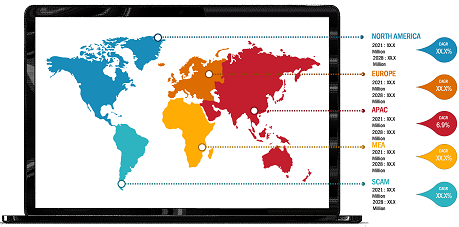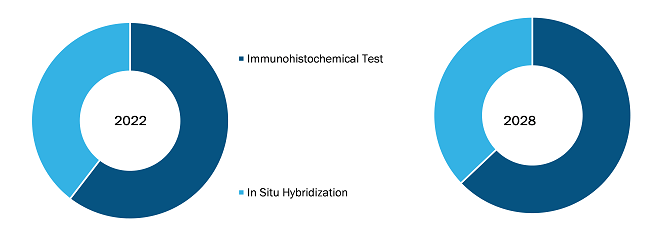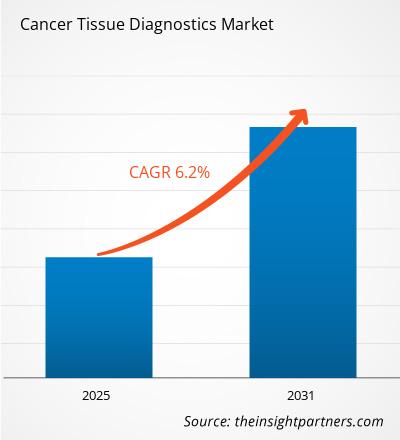がん組織診断市場は、2,538.31 米ドルから 2031 年までに 36 億 4,087 万米ドルに達すると予測されています2022年には100万人。 2022 年から 2031 年にかけて 6.2% の CAGR で成長すると推定されています。
がん組織診断技術は、悪性組織内の腫瘍を検出するために使用されます。ここ数年、免疫組織化学 (IHC) を使用して、腫瘍組織内の特定の抗原の検出が増加しました。非蛍光色原体の助けを借りて、スクリーニングは従来の顕微鏡法で分析されます。がん組織の診断のために最近開発された技術があります。蛍光 in situ ハイブリダイゼーションは、ゲノムの遺伝子異常を調べるために使用されます。ハイブリダイズしたデオキシリボ核酸 (DNA) は、特定のプローブで検査されます。
がん組織診断市場は次の基準に基づいて分割されています。 検査の種類と地域。市場は検査の種類に基づいて、免疫組織化学検査と in situ ハイブリダイゼーション検査に分類されます。 2022 年には、免疫組織化学検査セグメントがより大きな市場シェアを獲得しました。同じセグメントの市場も、今後数年間でより速いペースで成長すると予想されています。がん組織診断市場は地理的に、北米、ヨーロッパ、アジア太平洋、中東、およびアジア太平洋地域に大きく分割されています。アフリカ、そして南と南。中米。アジア太平洋地域の市場は、アジア諸国におけるがんの罹患率の上昇と人口の高齢化の増加により、予測期間中に最も高い率で成長すると予想されています。日本政府は、国内のがん治療の質を向上させ、がんに対する意識を高めるために、複数の取り組みやプログラムを策定し、敷設してきました。 WHOのデータによると、中国では2021年に45,68,754人の新たながん症例が検出され、3,002,899人ががんによる死亡を記録した。がん組織診断レポートは、市場に関する洞察と詳細な分析を提供し、次のことを強調している。市場の傾向、技術の進歩、市場のダイナミクス、世界をリードする市場プレーヤーの競争分析などのパラメーター。
戦略的洞察
がん組織診断市場にとって有利な地域

市場洞察
新製品の発売と FDA の承認、および予測期間中のがん組織診断市場を促進するがん組織診断への投資の増加
主要な市場関係者のほとんどが、最大限の効果を提供する幅広いがん診断製品の製造に携わっています。利点と早期診断。 2022 年 6 月、ロシュは最新の高度な組織染色プラットフォームである BenchMark ULTRA PLUS システムの発売を発表しました。このシステムにより、迅速かつ正確な検査結果が得られるため、臨床医は患者の治療行程に関してタイムリーな決定を下すことができます。
2022 年 3 月、イルミナは、さまざまながん変異をプロファイルし、患者を標的療法に誘導するのに役立つように設計された新しい体外診断検査をヨーロッパで開始しました。したがって、診断と FDA の承認における絶え間ない技術開発により、市場の成長が加速します。
さらに、組織診断はがん治療において極めて重要です。がん組織の診断は、治療のペースと手順を決定する上で重要な役割を果たします。早期発見はがんの死亡率を下げるのに役立ちます。したがって、医療専門家、市場関係者、政府当局は新しい診断および治療施設を導入しています。したがって、投資の増加と償還政策の改善により、がん組織診断市場の成長が促進されます。
2021 年 5 月、QIAGEN NV は、therascreen KRAS RGQ PCR キット (therascreen KRAS キット) が、治療を支援するコンパニオン診断薬として米国規制当局の承認を取得した後、コンパニオン診断薬 (CDx) の表示範囲の拡大を開始しました。アムジェン社(AMGN)が開発・販売する新たに承認された治療法であるLUMAKRASTM(ソトラシブ)による治療の対象となり得る非小細胞肺がん(NSCLC)患者の特定。さらに、2021年1月、イルミナとロシュはNGSの実現を目的とした15年間の非独占的協力契約を締結しました。がんリスクの予測、検出、診断、治療、モニタリングを変革する可能性。体外診断薬(IVD)およびコンパニオン診断薬(CDx)の取り組みを含むパートナーシップの価値は明らかにされていない。同社は 2021 年に、画像処理を高速化し、自動病理画像分析を提供する AIforia クラウド プラットフォームを立ち上げました。このように、がん組織診断におけるコラボレーションの増加と新しい技術プラットフォームは画期的な技術の出現につながり、今後数年間の市場の成長を促進すると予想されています。
テスト タイプ インサイト
検査の種類に基づいて、がん組織診断市場は免疫組織化学検査と in situ ハイブリダイゼーション検査に分類されます。 2022 年には、免疫組織化学検査セグメントがより大きな市場シェアを獲得しました。さらに、同セグメントの市場は、この技術の費用対効果の高さにより、今後数年間でより速いペースで成長すると予想されています。さらに、この技術は簡単に利用できるため、技術に基づく製品の数の増加がこの分野の成長をさらに促進すると予想されます。
<スパンスタイル="font-family: verdana, Geneva, sans-serif; font-size: 10pt;">
- 2022 年 6 月、ロシュは最新の先進システムである BenchMark ULTRA PLUS システムの発売を発表しました。組織染色プラットフォーム。このシステムにより、迅速かつ正確な検査結果が得られるため、臨床医は患者の治療計画に関してタイムリーな決定を下すことができます。
- 2022 年 3 月、イルミナは、さまざまながんの変異をプロファイルし、患者の診断を支援することを目的とした新しい体外診断検査をヨーロッパで開始しました。
- 2021 年 5 月、QIAGEN NV は、therascreen KRAS RGQ PCR キット (therascreen KRAS キット) が以下を支援するコンパニオン診断として米国規制当局の承認を取得した後、そのコンパニオン診断 (CDx) クレームの範囲を拡大しました。アムジェン社 (AMGN) が開発、販売する新たに承認された治療法である LUMAKRASTM (ソトラシブ) による治療の対象となり得る非小細胞肺がん (NSCLC) 患者の特定。
- 2021 年 1 月、イルミナとロシュは、がんリスクの予測、検出、診断、治療、モニタリングを変革する NGS の可能性を実現することを目的とした 15 年間の非独占的協力契約に署名しました。体外診断薬 (IVD) およびコンパニオン診断薬 (CDx) の取り組みを含むパートナーシップは明らかにされていません。
- 2021 年 6 月、アジレント テクノロジー株式会社は、PD-L1 IHC 22C3 pharmDx アッセイについて米国食品医薬品局 (FDA) の承認を取得しました。このアッセイは、頭頸部の患者を識別するために承認されています。メルク社製の抗 PD-1 療法であるキイトルーダ (ペムブロリズマブ) による治療のための扁平上皮癌 (HNSCC)。
- 2021 年 6 月、サーモフィッシャーサイエンティフィックの Oncomine Dx Target テストは日本の厚生労働省から償還対象となりました。このテストは現在、日本で市販されています。この償還により、同社はNSCLC の診断。\
- 2021 年 5 月、ロシュは、体外診断用 ROS1 免疫組織化学 (IHC) アッセイである VENTANA ROS1 (SP384) ウサギ モノクローナル一次抗体を発売しました。この発売により、同社はより優れた革新的な製品を提供できるようになりました。
会社概要
- F. ホフマン ラ ロッシュ株式会社
- サーモ フィッシャー サイエンティフィック社
- Bio Rad Laboratories Inc
- アボット
- Enzo Life Sciences, Inc
- Agilent Technologies, Inc
- Cancer Genetics Inc
- Merck KGaA (Sigma-Aldrich Co. LLC)
- ダナハー コーポレーション
- アブカム株式会社
- 過去2年間の分析、基準年、CAGRによる予測(7年間)
- PEST分析とSWOT分析
- 市場規模価値/数量 - 世界、地域、国
- 業界と競争環境
- Excel データセット


- Organoids Market
- Electronic Signature Software Market
- Nuclear Decommissioning Services Market
- Biopharmaceutical Contract Manufacturing Market
- Surgical Gowns Market
- Micro-Surgical Robot Market
- Saudi Arabia Drywall Panels Market
- Transdermal Drug Delivery System Market
- Genetic Testing Services Market
- Medical Devices Market

Report Coverage
Revenue forecast, Company Analysis, Industry landscape, Growth factors, and Trends

Segment Covered
This text is related
to segments covered.

Regional Scope
North America, Europe, Asia Pacific, Middle East & Africa, South & Central America

Country Scope
This text is related
to country scope.
Trends and growth analysis reports related to Life Sciences : READ MORE..
The List of Companies
- F. Hoffmann-La Roche Ltd.
- Danaher Corporation
- Thermo Fisher Scientific Inc.
- Bio Rad Laboratories Inc.
- Abbott
- Enzo Life Sciences, Inc.
- Agilent Technologies, Inc.
- Cancer Genetics Inc.
- Merck KGaA (Sigma-Aldrich Co. LLC)
- Abcam plc.
The Insight Partners performs research in 4 major stages: Data Collection & Secondary Research, Primary Research, Data Analysis and Data Triangulation & Final Review.
- Data Collection and Secondary Research:
As a market research and consulting firm operating from a decade, we have published and advised several client across the globe. First step for any study will start with an assessment of currently available data and insights from existing reports. Further, historical and current market information is collected from Investor Presentations, Annual Reports, SEC Filings, etc., and other information related to company’s performance and market positioning are gathered from Paid Databases (Factiva, Hoovers, and Reuters) and various other publications available in public domain.
Several associations trade associates, technical forums, institutes, societies and organization are accessed to gain technical as well as market related insights through their publications such as research papers, blogs and press releases related to the studies are referred to get cues about the market. Further, white papers, journals, magazines, and other news articles published in last 3 years are scrutinized and analyzed to understand the current market trends.
- Primary Research:
The primarily interview analysis comprise of data obtained from industry participants interview and answers to survey questions gathered by in-house primary team.
For primary research, interviews are conducted with industry experts/CEOs/Marketing Managers/VPs/Subject Matter Experts from both demand and supply side to get a 360-degree view of the market. The primary team conducts several interviews based on the complexity of the markets to understand the various market trends and dynamics which makes research more credible and precise.
A typical research interview fulfils the following functions:
- Provides first-hand information on the market size, market trends, growth trends, competitive landscape, and outlook
- Validates and strengthens in-house secondary research findings
- Develops the analysis team’s expertise and market understanding
Primary research involves email interactions and telephone interviews for each market, category, segment, and sub-segment across geographies. The participants who typically take part in such a process include, but are not limited to:
- Industry participants: VPs, business development managers, market intelligence managers and national sales managers
- Outside experts: Valuation experts, research analysts and key opinion leaders specializing in the electronics and semiconductor industry.
Below is the breakup of our primary respondents by company, designation, and region:

Once we receive the confirmation from primary research sources or primary respondents, we finalize the base year market estimation and forecast the data as per the macroeconomic and microeconomic factors assessed during data collection.
- Data Analysis:
Once data is validated through both secondary as well as primary respondents, we finalize the market estimations by hypothesis formulation and factor analysis at regional and country level.
- Macro-Economic Factor Analysis:
We analyse macroeconomic indicators such the gross domestic product (GDP), increase in the demand for goods and services across industries, technological advancement, regional economic growth, governmental policies, the influence of COVID-19, PEST analysis, and other aspects. This analysis aids in setting benchmarks for various nations/regions and approximating market splits. Additionally, the general trend of the aforementioned components aid in determining the market's development possibilities.
- Country Level Data:
Various factors that are especially aligned to the country are taken into account to determine the market size for a certain area and country, including the presence of vendors, such as headquarters and offices, the country's GDP, demand patterns, and industry growth. To comprehend the market dynamics for the nation, a number of growth variables, inhibitors, application areas, and current market trends are researched. The aforementioned elements aid in determining the country's overall market's growth potential.
- Company Profile:
The “Table of Contents” is formulated by listing and analyzing more than 25 - 30 companies operating in the market ecosystem across geographies. However, we profile only 10 companies as a standard practice in our syndicate reports. These 10 companies comprise leading, emerging, and regional players. Nonetheless, our analysis is not restricted to the 10 listed companies, we also analyze other companies present in the market to develop a holistic view and understand the prevailing trends. The “Company Profiles” section in the report covers key facts, business description, products & services, financial information, SWOT analysis, and key developments. The financial information presented is extracted from the annual reports and official documents of the publicly listed companies. Upon collecting the information for the sections of respective companies, we verify them via various primary sources and then compile the data in respective company profiles. The company level information helps us in deriving the base number as well as in forecasting the market size.
- Developing Base Number:
Aggregation of sales statistics (2020-2022) and macro-economic factor, and other secondary and primary research insights are utilized to arrive at base number and related market shares for 2022. The data gaps are identified in this step and relevant market data is analyzed, collected from paid primary interviews or databases. On finalizing the base year market size, forecasts are developed on the basis of macro-economic, industry and market growth factors and company level analysis.
- Data Triangulation and Final Review:
The market findings and base year market size calculations are validated from supply as well as demand side. Demand side validations are based on macro-economic factor analysis and benchmarks for respective regions and countries. In case of supply side validations, revenues of major companies are estimated (in case not available) based on industry benchmark, approximate number of employees, product portfolio, and primary interviews revenues are gathered. Further revenue from target product/service segment is assessed to avoid overshooting of market statistics. In case of heavy deviations between supply and demand side values, all thes steps are repeated to achieve synchronization.
We follow an iterative model, wherein we share our research findings with Subject Matter Experts (SME’s) and Key Opinion Leaders (KOLs) until consensus view of the market is not formulated – this model negates any drastic deviation in the opinions of experts. Only validated and universally acceptable research findings are quoted in our reports.
We have important check points that we use to validate our research findings – which we call – data triangulation, where we validate the information, we generate from secondary sources with primary interviews and then we re-validate with our internal data bases and Subject matter experts. This comprehensive model enables us to deliver high quality, reliable data in shortest possible time.

 このレポートの無料サンプルを入手する
このレポートの無料サンプルを入手する